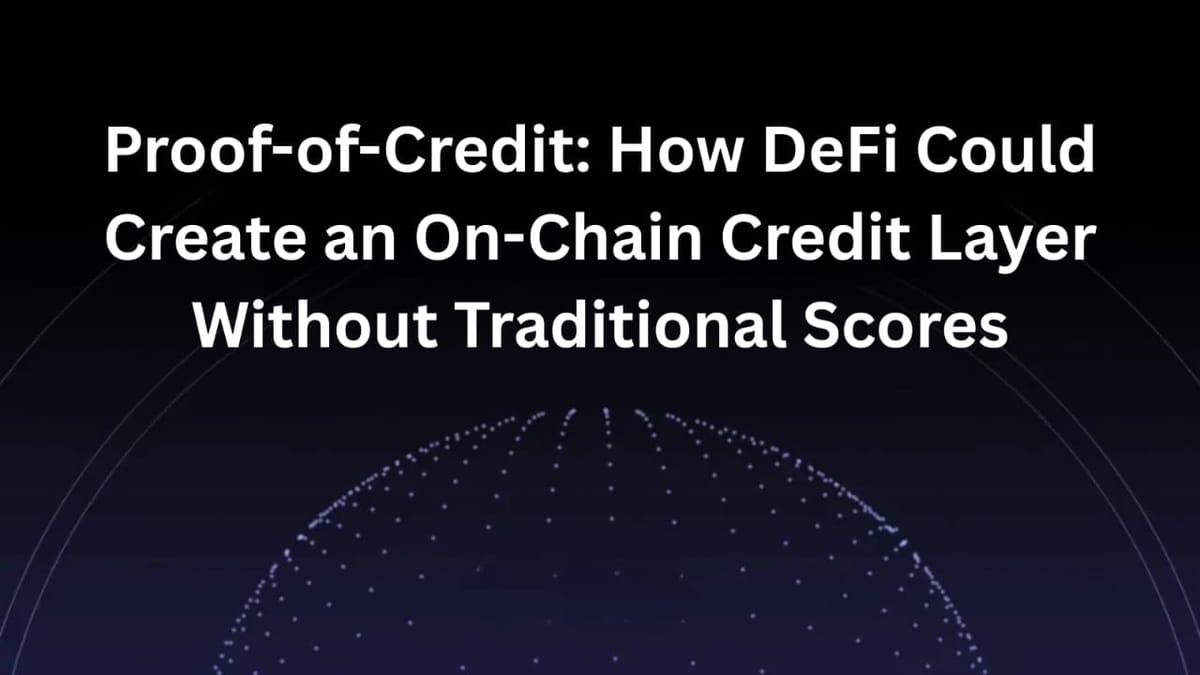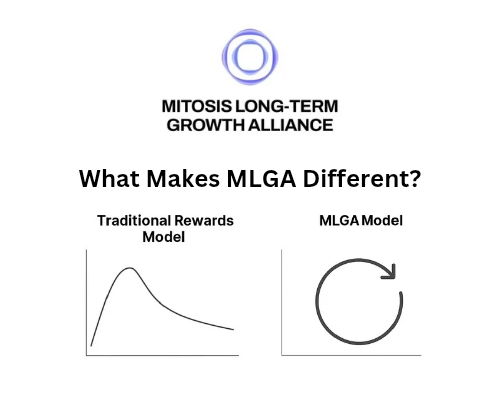Proof-of-Credit: How DeFi Could Create an On-Chain Credit Layer Without Traditional Scores

Introduction
The traditional credit scoring system has long been a cornerstone of financial services, determining who can access credit and under what terms. However, this system is fraught with limitations, including biases, lack of transparency, and exclusion of individuals without established credit histories. As decentralized finance (DeFi) continues to evolve, it presents an opportunity to create a more inclusive and equitable credit assessment framework through the concept of Proof-of-Credit. This article explores how DeFi could establish an on-chain credit layer that leverages interaction history, decentralized autonomous organization (DAO) trust, and cross-chain proofs to build Web3-native credit systems.
1. Understanding Traditional Credit Scoring
1.1 The Limitations of Traditional Credit Scores
Traditional credit scores are typically calculated using a variety of factors, including payment history, credit utilization, length of credit history, types of credit in use, and recent credit inquiries. While these factors can provide insights into an individual's creditworthiness, they also have significant drawbacks:
- Exclusion of the Underbanked: Many individuals, particularly those in developing countries or marginalized communities, lack access to traditional banking services and, consequently, do not have credit histories. This exclusion prevents them from obtaining loans or credit cards.
- Bias and Discrimination: Traditional credit scoring models can perpetuate biases, as they often rely on historical data that may reflect systemic inequalities. For example, individuals from certain demographic backgrounds may be unfairly penalized due to historical economic disparities.
- Lack of Transparency: The algorithms used to calculate credit scores are often proprietary and opaque, making it difficult for consumers to understand how their scores are determined or how to improve them.
- Static Nature: Traditional credit scores are updated infrequently, meaning they may not accurately reflect an individual's current financial situation or behavior.
2. The Emergence of DeFi and Its Potential
2.1 What is DeFi?
Decentralized finance (DeFi) refers to a broad range of financial applications built on blockchain technology that aim to recreate and improve upon traditional financial systems. DeFi platforms enable users to lend, borrow, trade, and earn interest on their assets without the need for intermediaries such as banks or financial institutions. Key features of DeFi include:
- Decentralization: DeFi applications operate on decentralized networks, reducing reliance on centralized authorities and increasing transparency.
- Smart Contracts: DeFi platforms utilize smart contracts—self-executing contracts with the terms of the agreement directly written into code—to automate processes and reduce the need for intermediaries.
- Accessibility: DeFi platforms are accessible to anyone with an internet connection, allowing individuals from all backgrounds to participate in financial activities.
2.1 The Opportunity for On-Chain Credit Systems
The rise of DeFi presents a unique opportunity to create an on-chain credit layer that addresses the limitations of traditional credit scoring. By leveraging blockchain technology, DeFi can facilitate the development of credit assessment models that are more inclusive, transparent, and dynamic.
3. Proof-of-Credit: A New Paradigm for Credit Assessment
3.1 What is Proof-of-Credit?
Proof-of-Credit is a decentralized approach to assessing creditworthiness that utilizes on-chain data and alternative credit assessment methods. Unlike traditional credit scores, which rely on historical borrowing and repayment data, Proof-of-Credit can incorporate a variety of on-chain data points, such as:
- Transaction History: Users' transaction histories on DeFi platforms can provide insights into their financial behavior, including their borrowing and repayment patterns.
- Asset Ownership: The ownership of digital assets, such as cryptocurrencies and NFTs, can be factored into credit assessments, reflecting an individual's financial stability.
- Participation in DeFi Protocols: Active participation in DeFi protocols, such as lending, borrowing, and liquidity provision, can demonstrate a user's engagement and reliability within the ecosystem.
3.2 Key Components of Proof-of-Credit
- On-Chain Data Aggregation: Users' on-chain activities are collected and analyzed to create a comprehensive credit profile. This can include their history of borrowing, lending, and participation in liquidity pools.
- Decentralized Identity: Users can create a digital identity on the blockchain that aggregates their financial activities, allowing for a more holistic view of their creditworthiness.
- Reputation Systems: These systems can be built on user interactions within DeFi platforms, rewarding positive behavior and penalizing defaults, thus creating a dynamic credit profile.
- Cross-Chain Proofs: As DeFi ecosystems become increasingly interconnected, cross-chain proofs can facilitate the sharing of credit data across different blockchain networks, enhancing the accuracy and reliability of credit assessments.
4. Mechanisms of On-Chain Credit Assessment
4.1 How On-Chain Credit Works
- Data Aggregation: Users' on-chain activities are collected and analyzed to create a credit profile. This can include their history of borrowing, lending, and participation in liquidity pools.
- Smart Contracts: Automated contracts facilitate the lending process, determining credit limits and interest rates based on the user's credit profile.
- Collateralization: Many DeFi platforms require over-collateralization, which can serve as a safety net for lenders while allowing borrowers to access credit based on their on-chain behavior.
- Dynamic Scoring: Unlike static credit scores, on-chain credit assessments can be updated in real-time, reflecting users' current financial situations and behaviors.
4.2 Benefits of On-Chain Credit Systems
- Inclusivity: By utilizing alternative data sources, individuals without traditional credit histories can access credit, promoting financial inclusion.
- Transparency: Blockchain technology ensures that credit assessments are transparent and verifiable, reducing the risk of fraud and bias.
- Lower Costs: DeFi eliminates intermediaries, potentially lowering the costs associated with borrowing and lending.
- Real-Time Updates: Credit profiles can be updated instantly, allowing for more accurate assessments and lending decisions.
5. Challenges and Considerations
1. Data Privacy
While on-chain data can enhance credit assessments, it also raises concerns about privacy. Users may be hesitant to share their financial activities on a public ledger, necessitating the development of privacy-preserving technologies.
2. Regulatory Compliance
As DeFi continues to grow, regulatory frameworks will need to adapt to address the unique challenges posed by on-chain credit systems. Ensuring compliance while maintaining the decentralized ethos of DeFi will be crucial.
3. Market Volatility
The value of collateral in DeFi can be highly volatile, which may impact borrowers' ability to maintain their loans and lenders' willingness to extend credit.
6. Case Studies and Examples
1. Aave and Credit Delegation
Aave, a leading DeFi lending platform, has implemented a credit delegation feature that allows users to delegate their creditworthiness to others. This system enables users to borrow without collateral, based on the trust established through their on-chain activities.
2. Centrifuge and Real-World Assets
Centrifuge allows users to tokenize real-world assets and use them as collateral in DeFi. This approach not only provides liquidity but also creates a new avenue for credit assessment based on tangible assets.
3. Maple Finance and Institutional Lending
Maple Finance focuses on providing loans to institutional borrowers using on-chain credit assessments. By analyzing borrowers' on-chain behavior, Maple can offer tailored lending solutions that traditional banks may overlook.
7. The Future of On-Chain Credit
Trends to Watch
- Integration with Traditional Finance: As DeFi matures, we may see greater integration with traditional financial institutions, creating hybrid models that leverage both on-chain and off-chain data.
- Enhanced Privacy Solutions: Innovations in zero-knowledge proofs and other privacy technologies will be essential for protecting user data while enabling credit assessments.
- Regulatory Developments: As regulators begin to understand DeFi, clearer guidelines will emerge, shaping the future of on-chain credit systems.
- Interoperability: The ability for different DeFi platforms to share credit data securely will enhance the overall effectiveness of on-chain credit assessments.
Conclusion
Proof-of-Credit represents a transformative approach to credit assessment in the DeFi space, offering a more inclusive, transparent, and efficient alternative to traditional credit scoring systems. By leveraging on-chain data and decentralized identity, DeFi can create a robust credit layer that empowers individuals and fosters financial inclusion. However, addressing challenges related to privacy, regulation, and market volatility will be crucial for the successful implementation of on-chain credit systems.

Comments ()